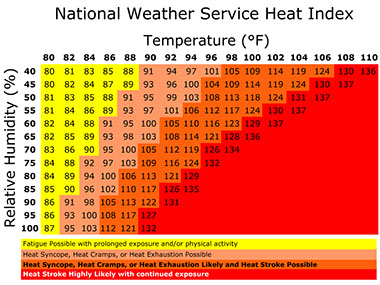EMERGENCY RESPONSE WEB APP
Heat Illnesses are 100% Preventable. Know and understand the heat index, risk factors that increase the likelihood of heat illness, and how to prevent heat illness.

The National Weather Service Heat Index shown above shows the risk for a relatively healthy person who is not exerting themselves. Other environmental and personal risk factors can increase the likelihood of suffering a heat related index.
Environmental Factors that Increase Risk
Personal Factors that Increase Risk
Other Factors that Increase Risk
It takes up to 14 days to get used to temperature changes.
Any time the temperature is more than 10°F hotter than what you have been used to over the past 5 days, take the time to properly acclimate.
During the acclimatization period, take more frequent rest breaks in shaded or cool areas and limit the amount of physical exertion.
Drink four cups (1 quart) of water every hour. Avoid caffinated and alcoholic beverages. Sports drinks can help add electrolytes but they are not as effective as water is at hydrating the body so, if you drink sports drinks, use them as supplements to the four cups of water.
Take cool down breaks in shaded or cool areas at least every two hours and more frequently if you are not acclimated to the heat.
NOTE: No Yaskawa associate shall perform work or any hazardous activities including working with live electrical power, driving, or operating powered tools, if they are showing any signs of potential heat illness.
Does the person exhibit any of the following symptoms?
If Yes
These are signs of possible Heat Stroke.
If No
The person may have heat exhaustion, heat syncope, or heat cramps if any of the following symptoms appear.
The first aid is the same for each of these conditions.
Associates who work in outdoor locations or in other work sites where the environmental risk factors for heat illness are present are are at risk for developing heat related illnesses if they do not protect themselves appropriately.
Yaskawa America's Heat Illness Prevention Policy applies to all Yaskawa associates and locations, with the most likely affected areas being:
Yaskawa's full Heat Illness Prevention Policy is located in Yaskawa's Safety Policies and Programs found at www.YaskawaSafety.com.
Field Service Managers and Supervisors
Acclimating to high heat areas can take between 4 and 14 days. Since the nature of field service work often does not allow for proper acclimatization, it is critical that associates drink at least 4-cups of water every hour and take at least a 15-minute rest break in shade or a cool area every two hours (or whenever they feel any signs of heat illness)
If the temperature exceeds 95°F, associates must communicate with their supervisor (or representative) at least every two hours for remote monitoring.
Yaskawa provides associates with clean water at no expense to the associate. Since field service associates work remotely, field service associates must being water with them. Field service associates must never assume water will be available at the worksite. Associates can either bring water from a Yaskawa home location, purchase water with a Yaskawa credit card, or purchase water and get reimbursed through submitting an expense report.
Associates must drink 4-cups (1 quart) of water every hour when temperatures are 80°F or above. Assume the job will take twice the amount of time expected to ensure the associate has enough water at the work site.
Caffinated beverages or soft drinks are not a substitute for water
The shade from vehicles and electric enclosures is not sufficient to provide cooling. If you cannot access shade from a building, trees, or an awning, associates can sit in car with air conditioning on. It may be necessary to drive the car to get sufficient air conditioning.
During the pre-work safety briefing, discuss heat illness prevention methods with the customer representative. Monitor each other for signs and symptoms of heat illness.
Associates must report to their supervisor and the customer if either the associate or the customer representative show any signs of heat illness. Associate MUST NOT WAIT until multiple signs occur. Heat illness can progress rapidly.
Associates who work outdoors in high heat regions must complete Yaskawa's Heat Illness Prevention Training annually.
Associates must notify their supervisor or EHS@Yaskawa.com if they have any questions regarding any information in the training or any other questions about heat illness prevention.